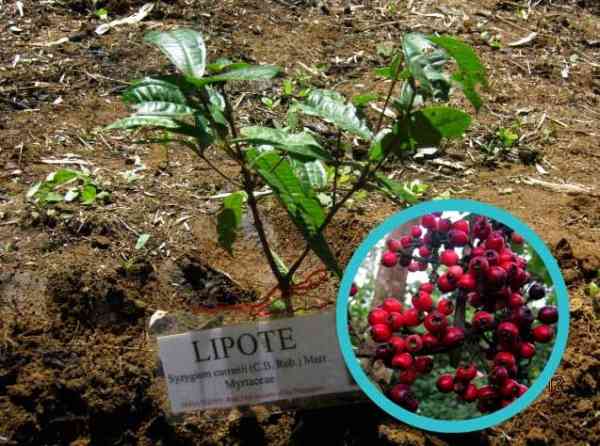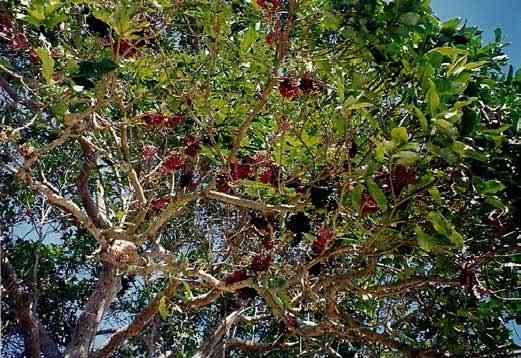People say that one good thing deserves another. The lipote does better than that as the fruit comes; not just as ones or pairs, but as whole clusters.

Many of us know duhat, the fruit of many childhood summers. Lipote looks similar to this tangy fruit. However, the duhat cluster has its fruits hanging more freely as each has a long stem whereas the lipote cluster is compact, almost like a ball attached to the tree branch.
Lipote is botanically known as Szygium curranii and is related to duhat and makopa which also belong to family Myrtaceae. Among Bicolanos it is called baligangwhile the Warays know it as igot. It is one of the fruits that the Philippines can call its very own as it is native to Luzon where it originated from primary forests at low to medium elevations.
When mature, the lipote fruit is a shiny dark red to a nearly black color. An ellipsoid berry, it is 1-2.5 cm in diameter, one-seeded, and in compact clusters that can have 50 or more individual fruits. The flesh is rather dry, crisp and with a pleasant slightly acidic flavor.

The tree can grow up to nine meters or more in height with branches that are distinctly four-angled. The timber can be used for construction. The leaves are glabrous, oblong obovate, opposite, 20-25 cm x 6-8 cm in size on the average, pointed, leathery, dark green, and shiny. The flowers are found to be in clusters along the mature stems, trunk and branches.
Lipote can be propagated through seeds or through grafting. Fruits may come 4-5 years after planting.
The lipote fruit is rather thin-skinned which limits its marketability in fresh ripe form. Lipote can still be enjoyed as a pickle, preserve, jelly, jam or beverage. It is said to be also good for wine-making. Methods for the processing of lipote into jams, jellies and juice, similar to those for duhat and guava, have been developed by the Cavite State University (CaVSU) in its effort to demonstrate the usefulness of lipote as a raw material for food processing.
According to Dr. Roberto Coronel, the ripe lipote fruit has 83 percent edible portion which contains (per 100 g) 83.4 g water, 77 kcal energy, 0.7 g protein, 2.5 g fat, 12.9 g carbohydrates, 1.7 g crude fiber, 93 mg calcium, 22 mg phosphorus, 0.2 mg iron, 50 µg ß-carotene, 10 µg total Vitamin A, 0.01 mg thiamin, 0.02 mg riboflavin, 0.3 mg niacin, and 16 mg ascorbic acid.
As is true with many indigenous trees, lipote is now rarely found in its natural habitat, a fact that drives home the need to implement conservation measures. For agriculture, the best way to do this is to promote its usefulness as a highly nutritious food source. With better appreciation, demand will come leading to its wider propagation in the country. In its processed form, lipote may find its way into the local and export markets once entrepreneurs have looked into its economic potential.
Our elders may reminisce how they once tasted lipote. It is not too difficult to bring back the taste of lipote once more.
———
Sources:
1. Coronel, Roberto E. 2011.Important and Underutilized Edible Fruits of the Philippines. UPLB Foundation, Inc and DA-Bureau of Agricultural Research. Manila.
2. Jules Janick and Robert E. Paull, eds. 2008. The Encyclopedia of Fruit and Nuts. CABI Publishing. Cambridge University Press. Cambridge, U.K. P.559. Retrieved 20 February 2013 through http://books.google.com.ph/books?id=cjHCoMQNkcgC&pg=PA559&lpg=PA559&dq=syzygium+curranii&source=bl&ots=u_0l6v2KXZ&sig=OwR3QsqiW0pwlf9y9nXJC_cTp2M&hl=en&sa=X&ei=_XskUZjmEYWjiAf_rYHoBA&ved=0CC4Q6AEwAQ#v=onepage&q=syzygium%20curranii&f=false
3. Lipote. Philippine Fruit Association, Inc. Retrieved 28 February 2013 from https://www.philippinefruits.org/fruit-profile/j-k-l/lipote/
4. Reyes, Edith G. 2005. Processing of Philippine Berry into jelly, jam and juice. MARID Agribusiness 2005. Retrieved 20 February 2013 from https://philippinetambayan.com/2009/03/14/philippine-berry-into-jelly-jam-and-juice-part-1/
5. Szygium curranii. ASEAN Tropical Plant Database. Retrieved 20 February 2013 from http://211.114.21.20/tropicalplant/html/search01_view.jsp?rno=374&fno=&page=1&all=1
By: Victoriano B. Guiam Bar Digest

I have lipote trees here in Tanay,Rizal.They produce more fruits when planted along riversides!